Xinyi Yang
AnalogSeeker: An Open-source Foundation Language Model for Analog Circuit Design
Aug 14, 2025Abstract:In this paper, we propose AnalogSeeker, an effort toward an open-source foundation language model for analog circuit design, with the aim of integrating domain knowledge and giving design assistance. To overcome the scarcity of data in this field, we employ a corpus collection strategy based on the domain knowledge framework of analog circuits. High-quality, accessible textbooks across relevant subfields are systematically curated and cleaned into a textual domain corpus. To address the complexity of knowledge of analog circuits, we introduce a granular domain knowledge distillation method. Raw, unlabeled domain corpus is decomposed into typical, granular learning nodes, where a multi-agent framework distills implicit knowledge embedded in unstructured text into question-answer data pairs with detailed reasoning processes, yielding a fine-grained, learnable dataset for fine-tuning. To address the unexplored challenges in training analog circuit foundation models, we explore and share our training methods through both theoretical analysis and experimental validation. We finally establish a fine-tuning-centric training paradigm, customizing and implementing a neighborhood self-constrained supervised fine-tuning algorithm. This approach enhances training outcomes by constraining the perturbation magnitude between the model's output distributions before and after training. In practice, we train the Qwen2.5-32B-Instruct model to obtain AnalogSeeker, which achieves 85.04% accuracy on AMSBench-TQA, the analog circuit knowledge evaluation benchmark, with a 15.67% point improvement over the original model and is competitive with mainstream commercial models. Furthermore, AnalogSeeker also shows effectiveness in the downstream operational amplifier design task. AnalogSeeker is open-sourced at https://huggingface.co/analogllm/analogseeker for research use.
Rethinking Prompt-based Debiasing in Large Language Models
Mar 12, 2025
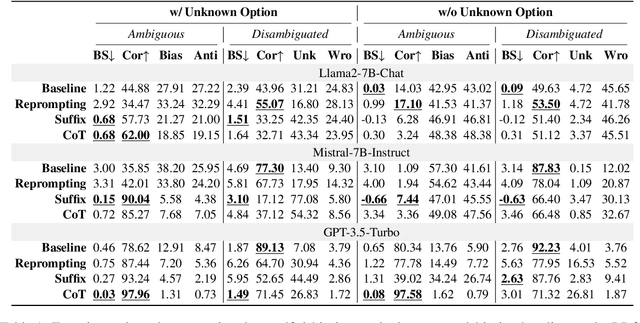
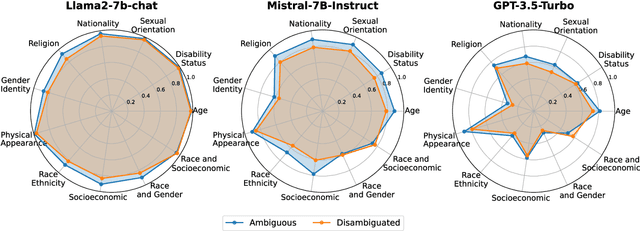
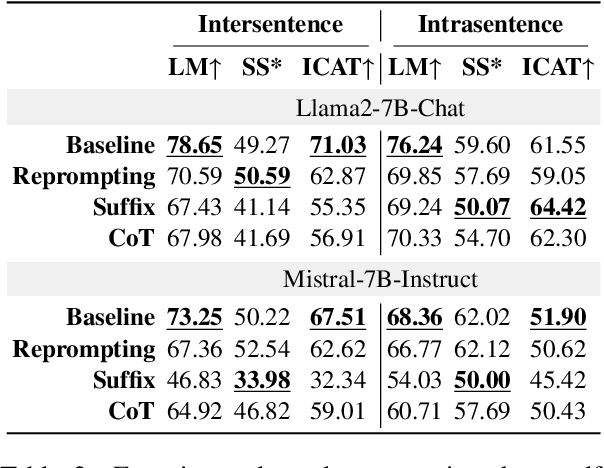
Abstract:Investigating bias in large language models (LLMs) is crucial for developing trustworthy AI. While prompt-based through prompt engineering is common, its effectiveness relies on the assumption that models inherently understand biases. Our study systematically analyzed this assumption using the BBQ and StereoSet benchmarks on both open-source models as well as commercial GPT model. Experimental results indicate that prompt-based is often superficial; for instance, the Llama2-7B-Chat model misclassified over 90% of unbiased content as biased, despite achieving high accuracy in identifying bias issues on the BBQ dataset. Additionally, specific evaluation and question settings in bias benchmarks often lead LLMs to choose "evasive answers", disregarding the core of the question and the relevance of the response to the context. Moreover, the apparent success of previous methods may stem from flawed evaluation metrics. Our research highlights a potential "false prosperity" in prompt-base efforts and emphasizes the need to rethink bias metrics to ensure truly trustworthy AI.
Multi-Robot System for Cooperative Exploration in Unknown Environments: A Survey
Mar 10, 2025Abstract:With the advancement of multi-robot technology, cooperative exploration tasks have garnered increasing attention. This paper presents a comprehensive review of multi-robot cooperative exploration systems. First, we review the evolution of robotic exploration and introduce a modular research framework tailored for multi-robot cooperative exploration. Based on this framework, we systematically categorize and summarize key system components. As a foundational module for multi-robot exploration, the localization and mapping module is primarily introduced by focusing on global and relative pose estimation, as well as multi-robot map merging techniques. The cooperative motion module is further divided into learning-based approaches and multi-stage planning, with the latter encompassing target generation, task allocation, and motion planning strategies. Given the communication constraints of real-world environments, we also analyze the communication module, emphasizing how robots exchange information within local communication ranges and under limited transmission capabilities. Finally, we discuss the challenges and future research directions for multi-robot cooperative exploration in light of real-world trends. This review aims to serve as a valuable reference for researchers and practitioners in the field.
Policy-to-Language: Train LLMs to Explain Decisions with Flow-Matching Generated Rewards
Feb 18, 2025Abstract:As humans increasingly share environments with diverse agents powered by RL, LLMs, and beyond, the ability to explain their policies in natural language will be vital for reliable coexistence. In this paper, we build a model-agnostic explanation generator based on an LLM. The technical novelty is that the rewards for training this LLM are generated by a generative flow matching model. This model has a specially designed structure with a hidden layer merged with an LLM to harness the linguistic cues of explanations into generating appropriate rewards. Experiments on both RL and LLM tasks demonstrate that our method can generate dense and effective rewards while saving on expensive human feedback; it thus enables effective explanations and even improves the accuracy of the decisions in original tasks.
Learning to Plan with Personalized Preferences
Feb 02, 2025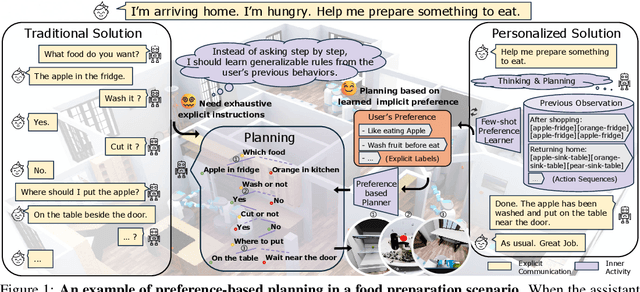

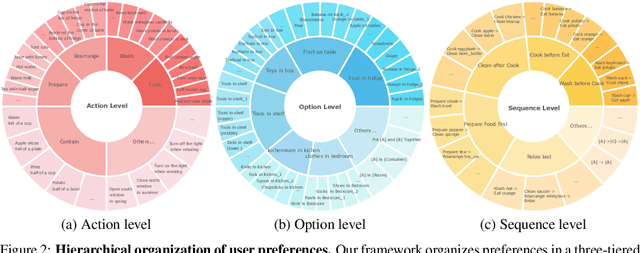

Abstract:Effective integration of AI agents into daily life requires them to understand and adapt to individual human preferences, particularly in collaborative roles. Although recent studies on embodied intelligence have advanced significantly, they typically adopt generalized approaches that overlook personal preferences in planning. We address this limitation by developing agents that not only learn preferences from few demonstrations but also learn to adapt their planning strategies based on these preferences. Our research leverages the observation that preferences, though implicitly expressed through minimal demonstrations, can generalize across diverse planning scenarios. To systematically evaluate this hypothesis, we introduce Preference-based Planning (PbP) benchmark, an embodied benchmark featuring hundreds of diverse preferences spanning from atomic actions to complex sequences. Our evaluation of SOTA methods reveals that while symbol-based approaches show promise in scalability, significant challenges remain in learning to generate and execute plans that satisfy personalized preferences. We further demonstrate that incorporating learned preferences as intermediate representations in planning significantly improves the agent's ability to construct personalized plans. These findings establish preferences as a valuable abstraction layer for adaptive planning, opening new directions for research in preference-guided plan generation and execution.
DENIAHL: In-Context Features Influence LLM Needle-In-A-Haystack Abilities
Nov 28, 2024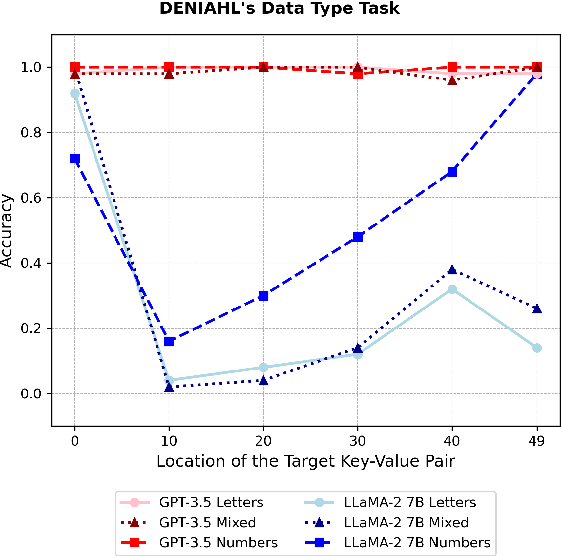
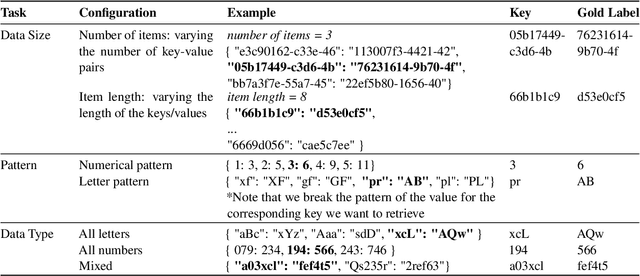
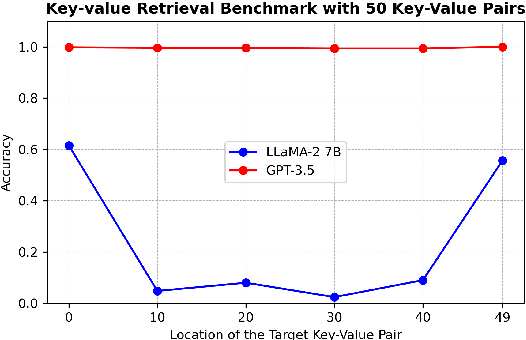

Abstract:The Needle-in-a-haystack (NIAH) test is a general task used to assess language models' (LMs') abilities to recall particular information from long input context. This framework however does not provide a means of analyzing what factors, beyond context length, contribute to LMs' abilities or inabilities to separate and recall needles from their haystacks. To provide a systematic means of assessing what features contribute to LMs' NIAH capabilities, we developed a synthetic benchmark called DENIAHL (Data-oriented Evaluation of NIAH for LLM's). Our work expands on previous NIAH studies by ablating NIAH features beyond typical context length including data type, size, and patterns. We find stark differences between GPT-3.5 and LLaMA 2-7B's performance on DENIAHL, and drops in recall performance when features like item size are increased, and to some degree when data type is changed from numbers to letters. This has implications for increasingly large context models, demonstrating factors beyond item-number impact NIAH capabilities.
DetectRL: Benchmarking LLM-Generated Text Detection in Real-World Scenarios
Oct 31, 2024Abstract:Detecting text generated by large language models (LLMs) is of great recent interest. With zero-shot methods like DetectGPT, detection capabilities have reached impressive levels. However, the reliability of existing detectors in real-world applications remains underexplored. In this study, we present a new benchmark, DetectRL, highlighting that even state-of-the-art (SOTA) detection techniques still underperformed in this task. We collected human-written datasets from domains where LLMs are particularly prone to misuse. Using popular LLMs, we generated data that better aligns with real-world applications. Unlike previous studies, we employed heuristic rules to create adversarial LLM-generated text, simulating advanced prompt usages, human revisions like word substitutions, and writing errors. Our development of DetectRL reveals the strengths and limitations of current SOTA detectors. More importantly, we analyzed the potential impact of writing styles, model types, attack methods, the text lengths, and real-world human writing factors on different types of detectors. We believe DetectRL could serve as an effective benchmark for assessing detectors in real-world scenarios, evolving with advanced attack methods, thus providing more stressful evaluation to drive the development of more efficient detectors. Data and code are publicly available at: https://github.com/NLP2CT/DetectRL.
3D-ViTac: Learning Fine-Grained Manipulation with Visuo-Tactile Sensing
Oct 31, 2024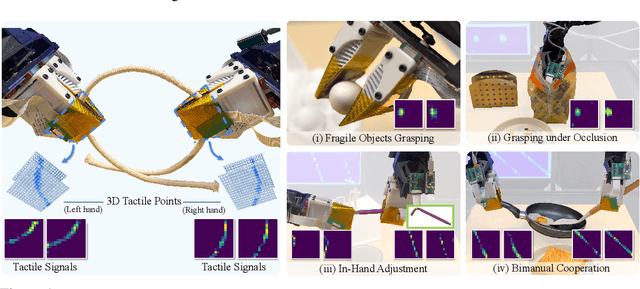

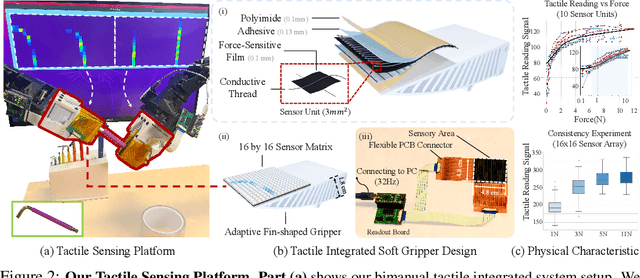

Abstract:Tactile and visual perception are both crucial for humans to perform fine-grained interactions with their environment. Developing similar multi-modal sensing capabilities for robots can significantly enhance and expand their manipulation skills. This paper introduces \textbf{3D-ViTac}, a multi-modal sensing and learning system designed for dexterous bimanual manipulation. Our system features tactile sensors equipped with dense sensing units, each covering an area of 3$mm^2$. These sensors are low-cost and flexible, providing detailed and extensive coverage of physical contacts, effectively complementing visual information. To integrate tactile and visual data, we fuse them into a unified 3D representation space that preserves their 3D structures and spatial relationships. The multi-modal representation can then be coupled with diffusion policies for imitation learning. Through concrete hardware experiments, we demonstrate that even low-cost robots can perform precise manipulations and significantly outperform vision-only policies, particularly in safe interactions with fragile items and executing long-horizon tasks involving in-hand manipulation. Our project page is available at \url{https://binghao-huang.github.io/3D-ViTac/}.
VLM2Vec: Training Vision-Language Models for Massive Multimodal Embedding Tasks
Oct 07, 2024



Abstract:Embedding models have been crucial in enabling various downstream tasks such as semantic similarity, information retrieval, and clustering. Recently, there has been a surge of interest in developing universal text embedding models that can generalize across tasks (e.g., MTEB). However, progress in learning universal multimodal embedding models has been relatively slow despite their importance. In this work, we aim to explore the potential for building universal embeddings capable of handling a wide range of downstream tasks. Our contributions are twofold: (1) MMEB (Massive Multimodal Embedding Benchmark), which covers 4 meta-tasks (i.e. classification, visual question answering, multimodal retrieval, and visual grounding) and 36 datasets, including 20 training and 16 evaluation datasets, and (2) VLM2Vec (Vision-Language Model -> Vector), a contrastive training framework that converts any state-of-the-art vision-language model into an embedding model via training on MMEB. Unlike previous models such as CLIP and BLIP, VLM2Vec can process any combination of images and text to generate a fixed-dimensional vector based on task instructions. We build a series of VLM2Vec models on Phi-3.5-V and evaluate them on MMEB's evaluation split. Our results show that \model achieves an absolute average improvement of 10% to 20% over existing multimodal embedding models on both in-distribution and out-of-distribution datasets in MMEB.
ReGenesis: LLMs can Grow into Reasoning Generalists via Self-Improvement
Oct 03, 2024Abstract:Post-training Large Language Models (LLMs) with explicit reasoning trajectories can enhance their reasoning abilities. However, acquiring such high-quality trajectory data typically demands meticulous supervision from humans or superior models, which can be either expensive or license-constrained. In this paper, we explore how far an LLM can improve its reasoning by self-synthesizing reasoning paths as training data without any additional supervision. Existing self-synthesizing methods, such as STaR, suffer from poor generalization to out-of-domain (OOD) reasoning tasks. We hypothesize it is due to that their self-synthesized reasoning paths are too task-specific, lacking general task-agnostic reasoning guidance. To address this, we propose Reasoning Generalist via Self-Improvement (ReGenesis), a method to self-synthesize reasoning paths as post-training data by progressing from abstract to concrete. More specifically, ReGenesis self-synthesizes reasoning paths by converting general reasoning guidelines into task-specific ones, generating reasoning structures, and subsequently transforming these structures into reasoning paths, without the need for human-designed task-specific examples used in existing methods. We show that ReGenesis achieves superior performance on all in-domain and OOD settings tested compared to existing methods. For six OOD tasks specifically, while previous methods exhibited an average performance decrease of approximately 4.6% after post training, ReGenesis delivers around 6.1% performance improvement. We also conduct in-depth analysis of our framework and show ReGenesis is effective across various LLMs and design choices.
 Add to Chrome
Add to Chrome Add to Firefox
Add to Firefox Add to Edge
Add to Edge